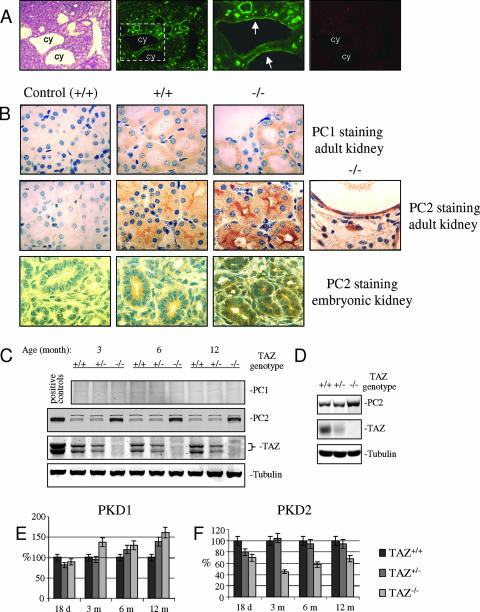FIG. 2.
TAZ affects levels of PC2 expression without an effect on PKD2 RNA levels. (A) Origins of renal cysts in a 2-week-old TAZ−/− mouse. Panels left to right: H&E staining; staining with fluorescein isothiocyanate-coupled Lotus tetragonolobus agglutinin as a marker of proximal tubules; higher magnification of the area outlined in second panel with arrows indicating staining of cells lining a cyst; staining of the same section with tetramethyl rhodamine isothiocyanate-coupled DBA as a marker of collecting ducts. (B) Expression levels and localization of PC1 and PC2 in mouse kidneys. Magnification, ×400. Upper panels: staining of kidneys of 3-month-old mice with anti-PC1 antibody (sc-10374; Santa Cruz). Panels left to right: +/+ kidney with normal IgG control, +/+ with anti-PC1; −/− with anti-PC1. Middle panels: staining of kidneys of 3-month-old mice with anti-PC2 antibody 5459. Left to right: +/+ control with antibody preadsorbed with GST-PC2 C-terminal cytoplasmic fragment; +/+ anti-PC2; −/− anti-PC2. Lower panels: embryonic kidneys (14.5 days) with anti-PC2 antibody 5459. Left to right: +/+ with normal IgG control; +/+ anti-PC2; −/− anti-PC2. (C and D) Lysates from mouse kidney tissues (C) and cultured BMK cells (D) from +/+, +/−, and −/− mice were blotted with anti-PC1 (sc-25570; Santa Cruz), anti-PC2 antibody (5459), anti-β-tubulin (T0198; Sigma), and anti-TAZ antibodies. Positive controls are lysates from 293 cells transfected with PC2 and TAZ expression constructs. (E and F) Real-time PCR for PKD1 (E) and PKD2 (F) using total RNA extracts from +/+, +/−, and −/− mouse kidneys at different ages. Results are normalized to GAPDH.

